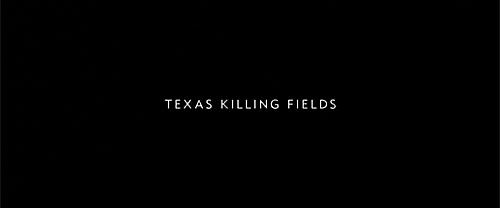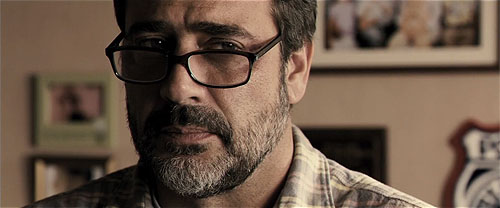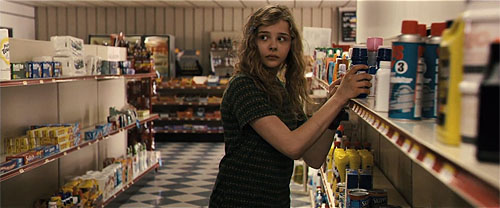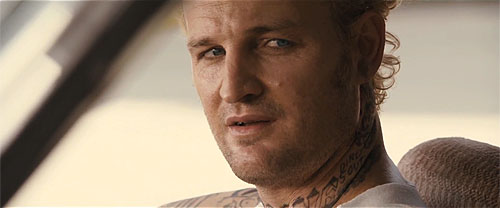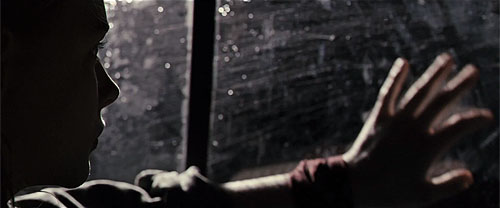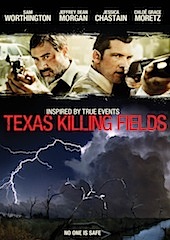 BUY FROM AMAZON: CLICK HERE!
BUY FROM AMAZON: CLICK HERE!
MSRP $14.98
RATED R
STUDIO ANCHOR BAY
RUNNING TIME 105 MINUTES
SPECIAL FEATURES
• DIRECTOR AND WRITER COMMENTARY
• THEATRICAL TRAILER
The Pitch
Brian Heigh (Jeffrey Dean Morgan) and Mike Souder (Sam Worthington) are a pair of mismatched detectives in Texas City. Heigh takes a special interest in an ongoing series of unsolved murders, where the bodies of young women are showing up in a swamp just outside his jurisdiction.
The Humans
Ami Canaan Mann (daughter of Michael Mann, who serves as producer here), Jeffrey Dean Morgan, Sam Worthington, Chloë Moretz, and Jessica Chastain.
The Nutshell
Hard-boiled meets Southern-fried in this serial killer police procedural inspired by true events.
The Lowdown
A title as good as “Texas Killing Fields” deserved a much better film. Once intended for Danny Boyle to direct, this project has an obvious sad story. Boyle left the project due to creative differences, and producer Michael Mann’s daughter, Ami Canaan Mann, was put into the director’s chair. She’s obviously a capable director, because the film’s issues are mostly narrative in nature, resulting in a muddled mess of frayed plotlines. This film has no thematic importance, no humor, and ultimately no impact.

“It took a whole thirty minutes to apply this silly beard in the makeup trailer, so you’re damn right I’m wearing it all day.”
Our cast of characters seem to have no obvious past, as if they all just poofed into existence just before the film started. Heigh (Jeffrey Dean Morgan) is ex-NYPD, but we have no idea why he moved to Texas City, how long he’s been there, or why he doesn’t have a New York accent. The character never really seems like a fish out of water. I understand that it’s easy to fall into “transplanted cop” stereotypes, but the film gives us almost no context for Heigh’s characterization. For instance, Heigh is deeply religious. Why? No reason. It’s a detail that serves no purpose in the narrative.
Souder (Sam Worthington) is a slightly more realized character, as is Chloë Moretz’s troubled teen character. But again, all of these characters act strangely with no explanation as to why. Souder is at times quiet and level-headed, sometimes violent and racist, but never likable. Moretz’s character habitually drinks milk of magnesia to calm her always-upset stomach, which I suppose tells us she’s under a lot of stress. But that odd, heavy handed bit of characterization only ends up putting her in harm’s way.
There is an interesting friction between our two detectives, but it’s ultimately squandered. Do they like each other? Do they despise each other? We don’t know. Souder and Heigh have the opposite of chemistry. The dynamic that exists between them is never properly explored. The same is true of Heigh’s strong desire to protect Ann Sliger (Moretz). Why do they have this relationship? We can guess, but this isn’t the kind of fascinating dynamic that warrants developing theories.
On a more complimentary note, the cast isn’t bad, but they seem out of place. I think Morgan, Worthington, and Moretz are all fine performers, but they don’t belong in this movie that only showed on three screens in its theatrical run. Yes, three.
The film is also well-shot and nicely lit, showing Michael Mann’s influence upon his daughter. The night scenes in Texas Killing Fields are very reminiscent of Collateral. Orange sodium vapor clashes with subtle highlights of neon blue and fluorescent green. The cinematography and color palette really are the film’s strongest assets. Aside from these points, the film’s single car chase is decently choreographed, and there is an effective home invasion scene that gave me goosebumps. Unfortunately, the few standout scenes can’t make up for a muddy plot.
Another strong point is the film’s atmospheric score, composed by Dickon Hinchliffe (Rampart, Winter’s Bone). Laden with haunting synths, twanging guitars, and driving electric bass, Hinchliffe’s score may in fact be the best thing about Texas Killing Fields. It’s reminiscent of Angelo Badalamenti’s haunting work on Lost Highway, with a Texan twist.
Killing Fields seems to spend quite a bit of it’s running time chasing down a major subplot that may or may not relate to our serial killer. I say “may or may not” because the subplot is never properly resolved. Now that I mention it, neither is our main plot. The reveal of the killer isn’t shocking, but it isn’t obvious either. What is shocking is that we are never given an explanation for the previous 100 minutes spent trying to understand why we’re watching boring white trash catch a motiveless killer.
The Package
Again, a disappointment. Considering that the look of the film is one of it’s stronger points, you’d think Anchor Bay would want to deliver a nice transfer. Unfortunately, the image is too dark and quite soft. The surround track isn’t awful, but the dialogue lacks clarity. Other features include a weak commentary from director Ami Canaan Mann and writer Donald Ferrarone, and a theatrical trailer.
Rating: 




Out of a Possible 5 Stars
